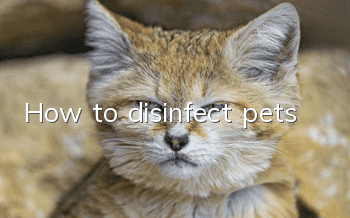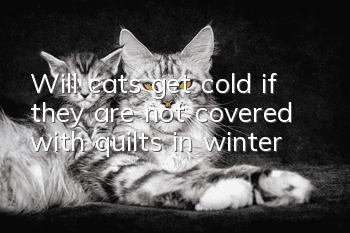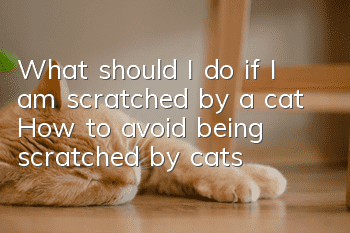How to disinfect pets

Raising pets requires people to spend a lot of time. Not only does everyone need to pay attention to the pet's diet and daily life, but it also requires cleaning the pet, cleaning the living environment, and even regular disinfection. This is for the cleanliness of the home environment and, most importantly, for Prevent illness in pets and family members.
Cages and kennels must be disinfected
Cages for raising animals can be made of stainless steel wire, plastic and other materials with smooth surfaces and easy to clean. Pay attention to regular cleaning and disinfection, at least once a week. The usual practice is to soak or soak the cage in a disinfectant solution for at least half an hour, then scrub it with washing powder, decontamination powder, etc., and finally rinse it with clean water and dry it. The disinfectant can be 3% hydrogen peroxide or 0.1% chlorine dioxide solution, which have a strong killing effect on viruses, spores, bacterial propagules, etc. In addition, you can also use 1%─2% bleaching powder supernatant. Since disinfectants may have adverse effects on pets, they should be rinsed thoroughly after disinfection.
Larger ornamental dogs and security dogs should build kennels outdoors. Choose a well-ventilated, well-lit area. The kennel floor is smooth and can be paved with artificial leather for easy cleaning.
The internal and external environment of cats and kennels must be cleaned frequently, feces, dirt and garbage should be cleaned up in time, and disinfection should be carried out frequently. Generally, the method of spraying or spraying disinfectants is used. The disinfectants can use 3% hydrogen peroxide, 0.1% chlorine dioxide solution, and 10%───20% bleaching powder emulsion.
If pets are kept indoors, they also need to pay attention to air disinfection.
Disinfection of pet fur
Pet fur will inevitably be contaminated with bacteria and parasites, so pet fur should be cleaned daily, that is, bathing the animal with warm water and disinfecting regularly. If the pet is sick, a large number of pathogenic bacteria or parasites will be adhered to the fur. When treating the pet, it must be disinfected. Here are some commonly used methods:
Chlorhexidine alcohol disinfection: Apply 75% chlorhexidine alcohol to wounds or wounds with cotton swabs. It can kill purulent Pseudomonas aeruginosa and prevent wound suppuration, but this disinfectant has certain irritation.
Iodophor disinfection Iodophor is a powerful disinfectant, which has a good killing effect on bacteria and mold, and has a certain irritation to the skin and mucous membranes. The skin at the injection site is usually disinfected and applied to local chronic inflammation.
Surfactant disinfection This type of disinfectant usually includes chlormethionine, chlorhexidine and chlorhexidine. The general concentrations for skin disinfection are: 1% promethazine, 0.5% chlorhexidine, and 0.05%─0.1% chlorhexidine. Among them, chlorhexidine has the strongest bactericidal effect and is still effective in the presence of pus and blood.It has low toxicity and irritation, making it an ideal disinfectant. All three of the above disinfectants can be used in pets’ “medicated baths”.
Oxidant disinfectants mainly include hydrogen peroxide (hydrogen peroxide), potassium permanganate, etc. Potassium permanganate is relatively easily available at home, and an aqueous solution with a concentration of 0.1% is generally used. Mainly used for wound disinfection.
Pay attention to the hygiene of pet food
The idea that diseases enter through the mouth is not limited to humans, but is also true for animals. For cats and other mammals, in addition to paying attention to the nutrition of their feed, they should also pay attention to food hygiene. The main points to note are:
For meat feed, it should be fully heated. In particular, animal viscera foods such as intestines, tripe, and liver must be cooked thoroughly; spoiled foods should not be fed to pets; leftovers and rice should be heated first before feeding.
Disinfection of tableware and other tools
You can choose tableware made of aluminum, cast iron, ceramic and plastic to facilitate soaking, cleaning and disinfection. Usually you can prepare a few more tableware, which should be replaced in time after each use, and residual food should be removed in time. Generally, you can use 0.01%───0.2% peracetic acid, 1% to 2% bleaching powder supernatant or 2% to 3% soda ash hot solution for soaking for about 10 minutes, then rinse with clean water after taking it out. , drain and prepare for next use.
Other breeding tools such as collars, brushing tools, and decorative items should also be disinfected. Appropriate disinfectants can be selected according to the materials for soaking and disinfection.
- What should I do if my newborn kitten is dying?
- Which is easier to raise, Chinchilla or Ragdoll? Cat raising tips!
- How to tell if a cat has ear mites or has dirty ears
- Why is it that cats eat a lot but are very thin?
- Why do cats have big and small eyes?
- How to make a Ragdoll cat explode?
- Is cat tapeworm harmful to humans? Can it be transmitted to humans?
- Can cats eat shrimp often?
- Is it okay to keep cats after disinfection for one week after feline plague?
- Can cats eat yogurt?



